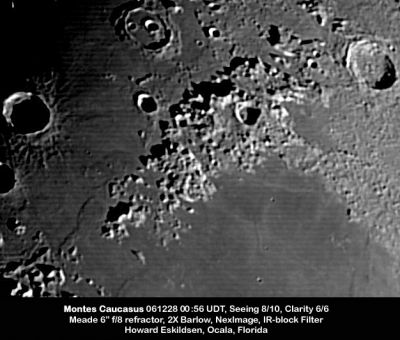Montes Caucasus
Contents
Montes Caucasus
|
Lat: 38.4°N, Long: 10.0°E, Diam: 445 km, Height: 3.65 km, Rükl: 13 |

Howard Eskildsen Montes Caucasus extends diagonally across the middle of this photo. The large craters on the left are Aristillus and Autolycus. The crater in the upper right is Eudoxus. At the top is the much shallower ring of Cassini with two prominent smaller craters on its floor. The feature in the extreme lower left corner is the Promontorium Fresnel region at the northern extremity of Montes Apenninus.
Images
LPOD Photo Gallery Lunar Orbiter Images Apollo Images
AS15-88-12001 (Apollo 15) shows an orbital view of the Montes Caucasus during high sun (the peaks of the Montes Caucasus are seen near and at the curved horizon, looking north). Research Danny Caes (see also the Hi-Res scan of that photograph).
Maps
(LAC zone 26D1) LAC map Geologic map
Description
Description: Elger
(IAU Directions) THE CAUCASUS.--consist of a massive wedge-shaped mountain land, projecting southwards, and partially dividing the Mare Imbrium from the Mare Serenitatis, both of which they flank. Though without peaks so lofty as those pertaining to the Alps, there is one, immediately west of the ring-plain Calippus, which, towering to 19,000 feet, surpasses any of which the latter system can boast.
Description: Wikipedia
Additional Information
- Depth data from Kurt Fisher database
- Viscardy, 1985: 3.65 km
- Cherrington, 1969: 5.3 km
- Note: the following are Greek-lettered peaks whose names were dropped from the official IAU nomenclature in 1973. Xi/Eta are X-Y coordinates expressed as a fraction of the lunar radius at zero libration.
- Montes Caucasus Beta's northern peak (Xi 0.104, Eta 0.525) rises 2400m +or- 300m (Boint 2001. Thesis. Augustana College, Sioux Falls, SD).- fatastronomer fatastronomer
- Montes Caucasus Beta's southern peak (Xi 0.102, Eta 0.515) rises 1400 +or- 300m (Boint 2001. Thesis. Augustana College, Sioux Falls, SD).- fatastronomer fatastronomer
- Montes Caucasus Gamma (Xi 0.107, 0.532) rises 2900m +or- 600m (Boint 2001. Thesis. Augustana College, Sioux Falls, SD).- fatastronomer fatastronomer
Nomenclature
- Named from terrestrial Caucasus Mountains.
- According to Whitaker (p. 203), the name Montes Caucasus was used by Hevelius for the feature now known as Montes Pyrenaeus.
- The name Caucasus in its modern sense was part of the original IAU nomenclature of Named Lunar Formations (1935). But it is unclear from Whitaker's book who first associated the name with the present feature.
- The name was Latinized to Montes Carpatus in IAU Transactions XIIB (1964).
- The southern spur of Montes Caucasus was once called Cap Faraday by J.F.J.Schmidt.
- According to Chart 19 in the Times Atlas of the Moon, only one peak in Montes Caucasus received a Greek letter designation: Caucasus Nu, at the part which was once called Cap Faraday by J.F.J.Schmidt.
- The space between Montes Caucasus and Montes Apenninus is sometimes called "The Great Pass" (connecting Mare Serenitatis and Mare Imbrium), or the Straits of Fresnel; thus named by Charles Wood.
- The "L"-shaped mountain at 43° north/ 11° east (in the northern part of the Montes Caucasus) is an interesting telescopic target during Full Moon, when the western slope of its north-south oriented part, and the southern slope of its east-west oriented part, look very much like an illuminated "L" or "sunlit corner". It is unofficially called Mons Elbruz by Danny Caes (note: the terrestrial Elbruz (Mount Elbrus) is also located in the Caucasus range). - DannyCaes Nov 18, 2007
LPOD Articles
A Table of Contents
Not a Crater
Low Oblique Tour
A and A
Rotated Mountains?
Bibliography
- Wood, C.A. Nov. 2001. From the Caucusus to the Alps. S&T Nov 2001 v102 p127
- Schmidt's "Cap Faraday": MAPPING AND NAMING THE MOON, Ewen A.Whitaker (page 224, Appendix L).
- NAMED LUNAR FORMATIONS, Mary Blagg.